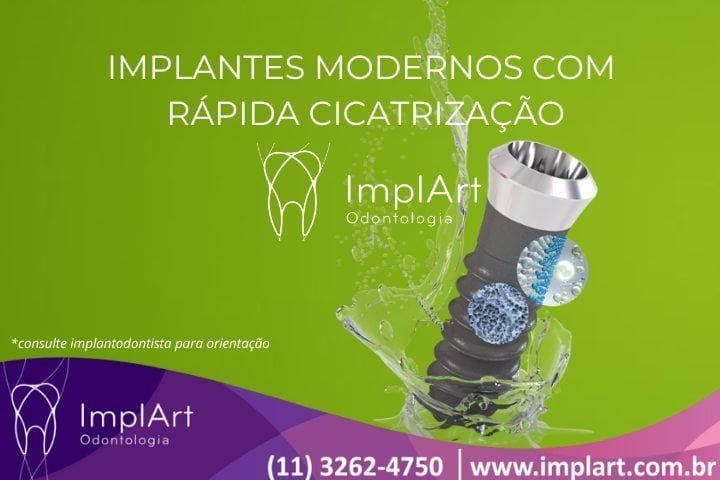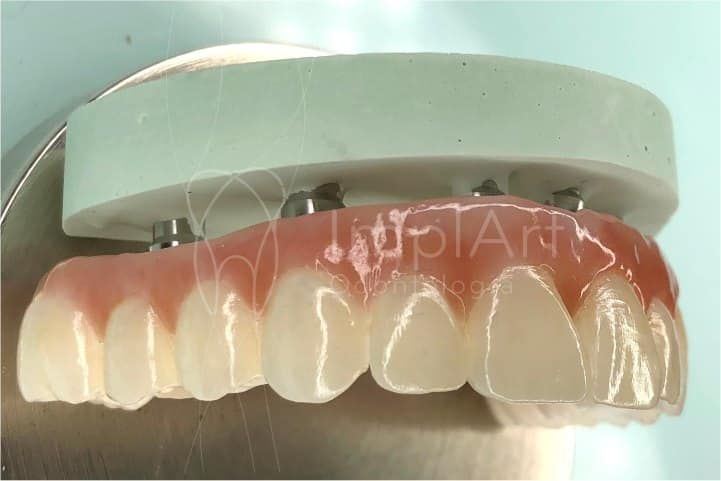Tooth replacement in 1 month with rapid implants and DayClinic
Rapid tooth replacement with dental implants
It is possible to replace a tooth by installing a dental implant with a CAD/CAM-designed crown within 1 month, in selected cases. This is possible because the ImplArt Dental Clinic works with Straumann Slactive implants. They have surface technology that favors and accelerates healing and the biological interaction between implants and bone (osseointegration).
A case of root fracture, for example, would require a dental implant as soon as possible, along with extraction. Successful osseointegration is what guarantees the stability of the implant to support the prosthesis and the masticatory load over the years. With normal implants, osseointegration usually occurs between 6 and 8 months. With Straumann Slactive implants, this time can be reduced to 3 to 4 weeks.
*Learn all about implants: Dental Implants at ImplArt Dental Clinic Specializing in Dental Implants
Rapid tooth replacement with implants
Will I lose a tooth during implant healing?
During this healing period, the patient wears a temporary prosthesis so as not to be left without a tooth. In the meantime, our prosthetics laboratory carries out the digital CAD/CAM design and manufacture of the definitive prosthesis using 3D printers. The design begins with a digital mold that is taken using an intraoral scanner, an intraoral camera that captures precise images of the patient’s mouth.
See more about single-tooth implants: Single-tooth implants

From these three-dimensional images, it is possible to design a prosthesis with the perfect fit and shape for tooth replacement. The prosthesis is made using a 3D printer. It can be made of porcelain, a very resistant, aesthetic material comparable to natural human teeth, and with a metal or zirconia internal structure.
Some people prefer to come twice to our clinic in a stage protocol for Implants instead of coming only once. This happens because if you stay for the full length of the treatment, you need to stay at least one month in Brazil but instead, if you choose a stage treatment you can come normally for one week and go back home. Then, after a few months, when you have availability, you can come again for another week and finish your work.
Find out more about our digital prosthetics laboratory.
It is worth noting that the possibility of tooth replacement with implant installation, gum grafting or bone grafting, with the definitive prosthesis in just 1 month, is only possible in selected cases.
An assessment by our specialized team will determine this possibility taking into account certain characteristics, such as bone volume and general state of health (in general, as well as of the teeth and gums).
The patient’s age can also influence the planning of dental implants. The rapid installation of a dental implant with a permanent crown for tooth replacement restores chewing ability, smile aesthetics and confidence in speaking and smiling.
Alternatives to dental implants for tooth replacement
As an alternative to implants, we can use dental prostheses in some cases. Adhesive dentures are a way of replacing a missing tooth. The main feature of this prosthesis is that it is attached to neighboring teeth using metal fins and dental adhesive.
If you have any questions about tooth replacement with dental implants, treatments for bruxism or average prices, please make an appointment or contact us. We’ll be happy to help you.
Dr. Roberto Markarian, implant dentist
Text written by DR. ROBERTO MARKARIAN – CRO-SP 73.583
Founder and Director of the ImplArt Dental Clinic – Dr. Roberto’s Linkedin profile

Dr. Roberto Markarian is a reference in dental implants and computerized dental prostheses in Brazil. As well as having more than 10,000 implants installed, he is a researcher who produces knowledge that is published worldwide in renowned scientific journals in the field of dentistry. He is responsible for promoting knowledge and high technology applied in all the treatments offered by the ImplArt Clinic.
- Post-Doctorate in Implant Dentistry – Univ SL Mandic (Campinas-SP) – 2020
- PhD in Implant Dentistry – Doctor of Implant Dentistry, Univ SL Mandic – 2017
- Dr. Roberto Markarian Specialist in Dental Implants at USP (Implant Dentist) – 2008
- Specialist in Prosthodontics (Prosthodontist ) by the CFO – 2006
- Master in Prosthodontics, USP – 2005
- Graduated as a Dental Surgeon from USP (São Paulo) – 2001
- Member of the Clinical Staff of Hospital Alemão Oswaldo Cruz
schedule your appointment at the implart clinic by phone or whatsapp

📲(11) 3262-4750
📲WhatsApp(11) 3262-4750












